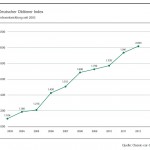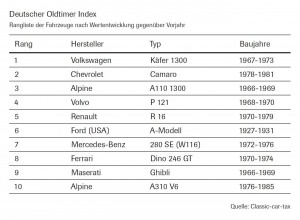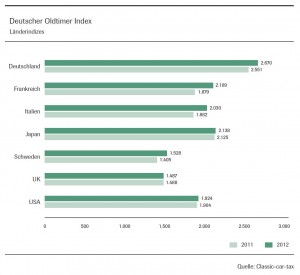
(English below)
Oldtimer-Weltverband FIVA legt Interessensgruppe für Historische Fahrzeuge des Europäischen Parlaments Ergebnisse einer Befragung von Eigentümern historischer Fahrzeuge, Oldtimer-Betrieben und -Clubs vor.
Anlässlich einer Tagung am 14. Oktober präsentierte die FIVA, Weltorganisation für historische Fahrzeuge, Abgeordneten des Europäischen Parlaments sowie Vertretern der EU-Kommission und des EU-Rates die Schlüsselergebnisse ihrer bisher größten Forschungsstudie. Zudem wurde die Interessensgruppe für Historische Fahrzeuge des Europäischen Parlaments unter Vorsitz des Abgeordneten Bernd Lange für die Amtszeit von 2014-2019 erneut berufen.
Im Rahmen der 2014 durchgeführten Studie wurden Daten von 20.000 Fahrzeughaltern, 1500 Clubs und 1000 Betrieben in 15 EU-Mitgliedsstaaten erhoben.
Der Studie zufolge wächst die Oldtimerbewegung, aber aufgrund einer durch die sozialen Medien bedingten Verlagerung sowie zunehmender Schwierigkeiten, gute Nachfolger für Vorstandsmitglieder zu finden, stehen Clubs vor besonderen Herausforderungen, während Fachbetriebe einen bevorstehenden Fachkräftemangel in ihrer Branche befürchten.
Die Studie bestätigte frühere Umfragen, wonach historische Fahrzeuge nur begrenzt, selektiv und kaum als Alltagsverkehrsmittel genutzt werden. Knapp 60% der historischen Pkw bringen es auf eine Jahresfahrleistung von weniger als 1000km; bei historischen Motorrädern und historischen Nutzfahrzeugen liegt der Prozentsatz sogar noch höher.
Zudem zeigte die Studie, dass Fahrzeugeigentümer jährlich etwa 3.800 Euro für Restauration, Ersatz- und Zubehörteile, Wartung und Reparatur ausgeben. Sie erlaubte auch eine sehr konservative Schätzung des Wertes der für die Oldtimerbewegung tätigen Betriebe, die einen Jahresumsatz von 5,5 Milliarden Euro erzielen und 100.000 bis 140.000 Arbeitsplätze schaffen. Allerdings sind die meisten Betriebe klein und haben Nachwuchsprobleme. Die FIVA wirbt daher bei den EU-Institutionen für Unterstützung bei Aus- und Weiterbildungsprogrammen zur fachlichen Qualifikation und zur Schaffung von Arbeitsplätzen.
Laut der Studie beteiligen sich 57% der Oldtimerclubs entweder als Veranstalter oder als Teilnehmer an mehrtätigen, grenzüberschreitenden Veranstaltungen. Diese leisten einen erheblichen Beitrag in der Tourismusbranche in Europa und schaffen mindestens 2.000 zusätzliche Arbeitsplätze. Interessant ist auch, dass 44% der Clubs wohltätige Organisationen unterstützen, z. B. indem sie Ausfahrten mit behinderten oder schwer kranken Menschen veranstalten.
In den kommenden Monaten wird die FIVA zusätzlich zu den am 14. Oktober präsentierten Schlüsselerkenntnissen weitere Umfrageergebnisse veröffentlichen.
Hintergrundinfo:
Die „Fédération Internationale des Véhicules Anciens“ (FIVA) wurde 1966 gegründet und vertritt weltweit über 85 Mitgliedsorganisationen in mehr als 60 Ländern, die wiederum mehr als 1,5 Millionen Eigentümer von Oldtimern aus allen Kategorien vertreten, d.h. Pkw, Rennwagen, Motorräder, Mopeds und Roller, Nutz- und Militärfahrzeuge, Busse, Traktoren usw.
Gemäß FIVA-Definition ist ein historisches Fahrzeug ein mechanisch angetriebenes Straßenfahrzeug, das mindestens 30 Jahre alt ist, im Sinne eines historisch einwandfreien Zustands erhalten und gepflegt ist, nicht als Alltagsverkehrsmittel genutzt wird, und daher Teil unseres technischen und kulturellen Erbes ist.
An den Befragungen nahmen nationale Mitgliedsorganisationen der FIVA in folgenden EU-Ländern teil: Österreich, Dänemark, Belgien, Tschechische Republik, Frankreich, Deutschland, Griechenland, Irland, Italien, Luxemburg, Niederlande, Polen, Spanien, Schweden, Vereinigtes Königreich.
Die Durchführung erfolgte in Zusammenarbeit mit dem Marktforschungsinstitut GfK, der TU Delft und der Fontys University of Applied Sciences.
—–
FIVA presents results from the European Survey on historic vehicles, investments and the economic factor
The world of historic vehicles in figures
FIVA presents results of survey into historic vehicle owners, businesses and clubs to the European Parliament Historic Vehicle Group
On 14 October, FIVA, the global historic vehicle interest organisation, presented the key findings of its largest research project to date at a meeting attended by Members of European Parliament, and European Commission and Council representatives and which marked the re-establishment of the European Parliament Historic Vehicle Group Chaired by Bernd Lange MEP for the 2014-19 term.
The research was undertaken in 2014 and gathered data from 20.000 historic vehicle owners, 1500 clubs and 1000 businesses in 15 EU member states.
The research showed that the historic vehicle movement is growing but that clubs face challenges created by “substitution” by social media and the growing difficulty in finding good candidates to replace board members, whilst specialized businesses are concerned about a lack of skilled labour for their business in the future.
The research reinforced previous surveys showing that the use of historic vehicles is limited, selective, and hardly ever as a daily means of transport. Nearly 60% of historic cars are driven less than 1000 km per year, while the percentage is even higher for historic motorcycles and historic commercial vehicles.
The research showed that owners annually spend around € 3800 on restoration, purchase of parts and accessories, maintenance and repairs and provided a very conservative estimate of the value of the businesses servicing the historic vehicle movement at € 5,5 billion per annum which provide 100.000 and 140.000 jobs. However, the businesses are predominantly small and face continuity problems. FIVA is therefore seeking support from the EU institutions for apprenticeship and training programs for the development of skills and creation of jobs.
The research further revealed that 57% of historic vehicle clubs organize or take part in cross border multi-day events. Such events contribute considerably to the European tourist sector, resulting in at least 2000 extra jobs. Interesting as well is that 44% of clubs contribute to charities, for instance in form of a tour with disabled or seriously ill people.
In next coming months FIVA will publish more survey results, in addition to the key findings presented on 14 October.
For further information. please contact: info@fiva.org or legislation@fiva.org
The “Fédération Internationale des Véhicules Anciens” (FIVA) was founded in 1966 and represents over 85 member organisations in more than 60 countries worldwide, which in turn represent more than 1,5 million historic vehicle owners, with vehicles from all categories: passenger cars, racing cars, motor cycles, mopeds and scooters, commercial and military vehicles, buses, tractors and more.
FIVA defines a historic vehicle as being a mechanically propelled road vehicle: which is at least 30 years old; which is preserved and maintained in a historically correct condition; which is not used as a means of daily transport; and which is therefore a part of our technical and cultural heritage.
FIVA national member organisations in the following EU countries contributed to the surveys: Austria, Denmark, Belgium, Czech Republic, France, Germany, Greece, Ireland, Italy, Luxemburg, Netherlands, Poland, Spain, Sweden, United Kingdom.
The surveys were carried out in cooperation with: market research company GfK, Delft University of Technology and Fontys University of applied Sciences.
Download the presentation here:
FIVA-Presentation (type:PDF)
and



